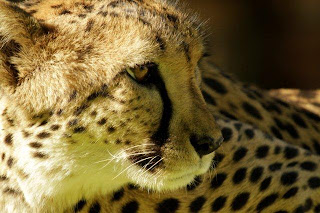Whilst the West side of our trip centred
around our interactions with people, the East side will have a larger focus on wildlife.
Namibia had much to offer us in
terms of its wildlife with our visit to the Cape Fur Seal colony at Cape Cross,
the Cheetah Park, and Etosha Game Reserve.
You could smell the Cape Cross
seals from a kilometre away and the smell got more pungent the closer we came. With
numbers fluctuating between 80,000 and 100,000, it’s not hard to see why there
was hardly an inch of free space on the beach. Seals covered the large expanse
of sand and were also frolicking in the water.
Most of them were just soaking
up the sun,
some with their heads comically upside-down
but all would quickly
snap out of it and strongly defend the small bit of beach they occupied, if any
other tried to take its spot.
On the way to Etosha, we stopped
in at a Cheetah Park where the cheetahs had been domesticated after they were
caught as pests (eating livestock) on a farm. Three of the cheetahs lived in
the house (harmoniously with a dog)
and the others roamed freely in a large
fenced off area behind the house.
Clearly they were comfortable in
their surroundings as one of them took a brief nap on a tractor.
All of us took
turns in patting the cheetah making it purr loudly,
and some of the men in our
group were licked by one. They weren’t at all interested in licking any of the
women for whatever reason, much to our dismay. Animals generally seem to take a
liking to Shaun so it’s not surprising that one cheetah started playing with
him and accidentally scratched his leg, drawing blood in the process. Another
was licking Ron’s arm, opting for the part where he had a fresh wound. And yet
another was licking Tom’s ear and shoulder.
Perhaps in response to this, the owners brought
out some fresh meat for them to eat instead!
We also watched the feeding of
the cheetahs in the fenced off area. They followed us as we drove through the
area, and were drooling and making excited cat-like calls as they eagerly
awaited ‘catching’ their hunk of meat for the day.
Last photo
courtesy of Dom
But perhaps our most incredible
experience with Namibian wildlife was in Etosha. We were only there for one day
but amongst other things we saw a watering hole with a mix of zebra, ostrich,
springbok and oryx (gemsbok),
banded mongoose that have a
burrow in the middle of the road!,
black-backed jackal,
a tawny eagle,
a zebra with a large chunk
missing from its behind,
a tower of giraffe with two of
the young ones necking
and the very bare Etosha pan
where we set up a series of perspective shots.
At night, we walked up to
the Moringa watering hole by our campsite and were excited to have come across
a black rhino drinking, lit up sporadically by the automated flood lights.
All
you could hear was whispering and the intermittent clicks of camera shutters.
After a while, another black rhino appeared and the two of them grunted in a
kind of aggressive acknowledgment of the other’s presence.
After the second
rhino had a drink, it approached the first and they began to fight, locking
horns with each other.
Every now and then they appeared to tire of the fight
and would both sit down opposite each other, rest, and then resume their fight
again in a few minutes. The funniest part for me was when they both farted in
sync with each other and their tails flipped up and down with the large volume
of air that rushed out! And just when we thought it couldn’t get any better, a
third black rhino appeared on the scene and got into a fight with one of the
other two!
After breaking for dinner, the
rhinos had moved on, but instead we came across a huge herd of elephant.
You
could hear the slurping and dripping of water as the elephants brought their
trunks up to their mouths and drunk their fill. A few of the guys on our truck
stayed up all night on animal watch at the watering hole but no other animals
came and to be fair it would have been hard to beat three black rhinos
fighting!




















































No comments:
Post a Comment